First People Health in Australia Assignment 2022
VerifiedAdded on 2022/10/11
|9
|3903
|15
Assignment
AI Summary
Contribute Materials
Your contribution can guide someone’s learning journey. Share your
documents today.
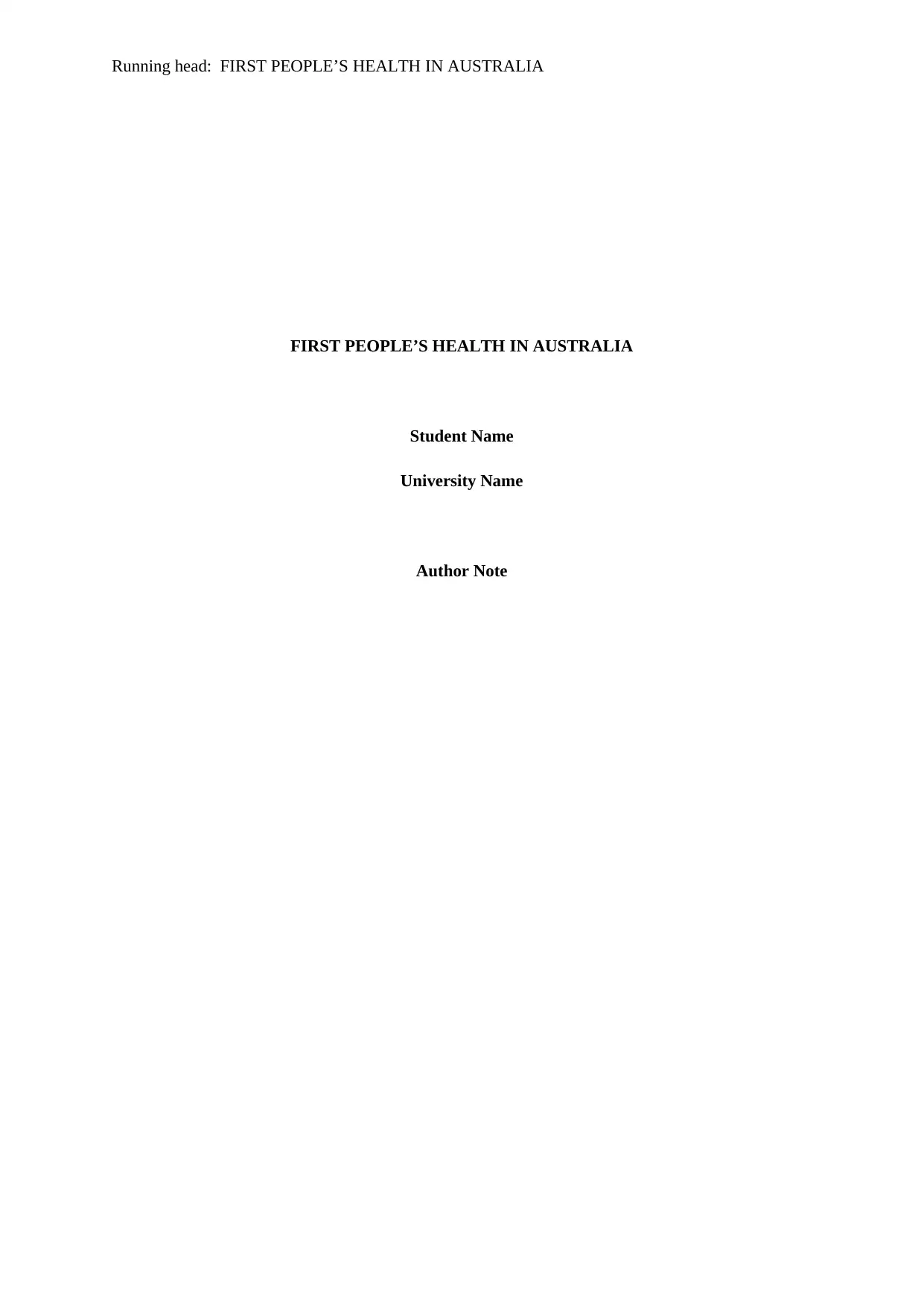
Running head: FIRST PEOPLE’S HEALTH IN AUSTRALIA
FIRST PEOPLE’S HEALTH IN AUSTRALIA
Student Name
University Name
Author Note
FIRST PEOPLE’S HEALTH IN AUSTRALIA
Student Name
University Name
Author Note
Secure Best Marks with AI Grader
Need help grading? Try our AI Grader for instant feedback on your assignments.
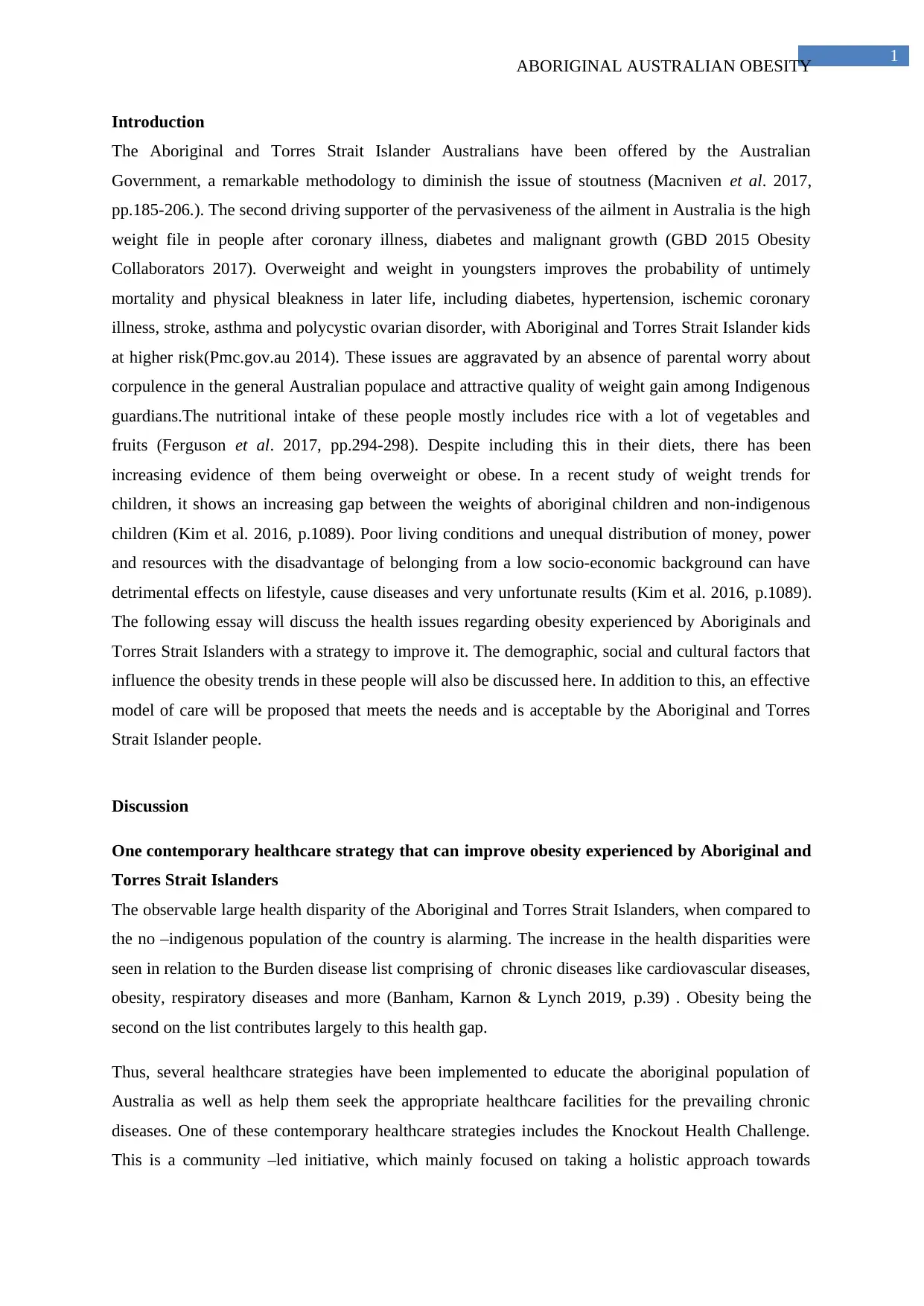
1
ABORIGINAL AUSTRALIAN OBESITY
Introduction
The Aboriginal and Torres Strait Islander Australians have been offered by the Australian
Government, a remarkable methodology to diminish the issue of stoutness (Macniven et al. 2017,
pp.185-206.). The second driving supporter of the pervasiveness of the ailment in Australia is the high
weight file in people after coronary illness, diabetes and malignant growth (GBD 2015 Obesity
Collaborators 2017). Overweight and weight in youngsters improves the probability of untimely
mortality and physical bleakness in later life, including diabetes, hypertension, ischemic coronary
illness, stroke, asthma and polycystic ovarian disorder, with Aboriginal and Torres Strait Islander kids
at higher risk(Pmc.gov.au 2014). These issues are aggravated by an absence of parental worry about
corpulence in the general Australian populace and attractive quality of weight gain among Indigenous
guardians.The nutritional intake of these people mostly includes rice with a lot of vegetables and
fruits (Ferguson et al. 2017, pp.294-298). Despite including this in their diets, there has been
increasing evidence of them being overweight or obese. In a recent study of weight trends for
children, it shows an increasing gap between the weights of aboriginal children and non-indigenous
children (Kim et al. 2016, p.1089). Poor living conditions and unequal distribution of money, power
and resources with the disadvantage of belonging from a low socio-economic background can have
detrimental effects on lifestyle, cause diseases and very unfortunate results (Kim et al. 2016, p.1089).
The following essay will discuss the health issues regarding obesity experienced by Aboriginals and
Torres Strait Islanders with a strategy to improve it. The demographic, social and cultural factors that
influence the obesity trends in these people will also be discussed here. In addition to this, an effective
model of care will be proposed that meets the needs and is acceptable by the Aboriginal and Torres
Strait Islander people.
Discussion
One contemporary healthcare strategy that can improve obesity experienced by Aboriginal and
Torres Strait Islanders
The observable large health disparity of the Aboriginal and Torres Strait Islanders, when compared to
the no –indigenous population of the country is alarming. The increase in the health disparities were
seen in relation to the Burden disease list comprising of chronic diseases like cardiovascular diseases,
obesity, respiratory diseases and more (Banham, Karnon & Lynch 2019, p.39) . Obesity being the
second on the list contributes largely to this health gap.
Thus, several healthcare strategies have been implemented to educate the aboriginal population of
Australia as well as help them seek the appropriate healthcare facilities for the prevailing chronic
diseases. One of these contemporary healthcare strategies includes the Knockout Health Challenge.
This is a community –led initiative, which mainly focused on taking a holistic approach towards
ABORIGINAL AUSTRALIAN OBESITY
Introduction
The Aboriginal and Torres Strait Islander Australians have been offered by the Australian
Government, a remarkable methodology to diminish the issue of stoutness (Macniven et al. 2017,
pp.185-206.). The second driving supporter of the pervasiveness of the ailment in Australia is the high
weight file in people after coronary illness, diabetes and malignant growth (GBD 2015 Obesity
Collaborators 2017). Overweight and weight in youngsters improves the probability of untimely
mortality and physical bleakness in later life, including diabetes, hypertension, ischemic coronary
illness, stroke, asthma and polycystic ovarian disorder, with Aboriginal and Torres Strait Islander kids
at higher risk(Pmc.gov.au 2014). These issues are aggravated by an absence of parental worry about
corpulence in the general Australian populace and attractive quality of weight gain among Indigenous
guardians.The nutritional intake of these people mostly includes rice with a lot of vegetables and
fruits (Ferguson et al. 2017, pp.294-298). Despite including this in their diets, there has been
increasing evidence of them being overweight or obese. In a recent study of weight trends for
children, it shows an increasing gap between the weights of aboriginal children and non-indigenous
children (Kim et al. 2016, p.1089). Poor living conditions and unequal distribution of money, power
and resources with the disadvantage of belonging from a low socio-economic background can have
detrimental effects on lifestyle, cause diseases and very unfortunate results (Kim et al. 2016, p.1089).
The following essay will discuss the health issues regarding obesity experienced by Aboriginals and
Torres Strait Islanders with a strategy to improve it. The demographic, social and cultural factors that
influence the obesity trends in these people will also be discussed here. In addition to this, an effective
model of care will be proposed that meets the needs and is acceptable by the Aboriginal and Torres
Strait Islander people.
Discussion
One contemporary healthcare strategy that can improve obesity experienced by Aboriginal and
Torres Strait Islanders
The observable large health disparity of the Aboriginal and Torres Strait Islanders, when compared to
the no –indigenous population of the country is alarming. The increase in the health disparities were
seen in relation to the Burden disease list comprising of chronic diseases like cardiovascular diseases,
obesity, respiratory diseases and more (Banham, Karnon & Lynch 2019, p.39) . Obesity being the
second on the list contributes largely to this health gap.
Thus, several healthcare strategies have been implemented to educate the aboriginal population of
Australia as well as help them seek the appropriate healthcare facilities for the prevailing chronic
diseases. One of these contemporary healthcare strategies includes the Knockout Health Challenge.
This is a community –led initiative, which mainly focused on taking a holistic approach towards
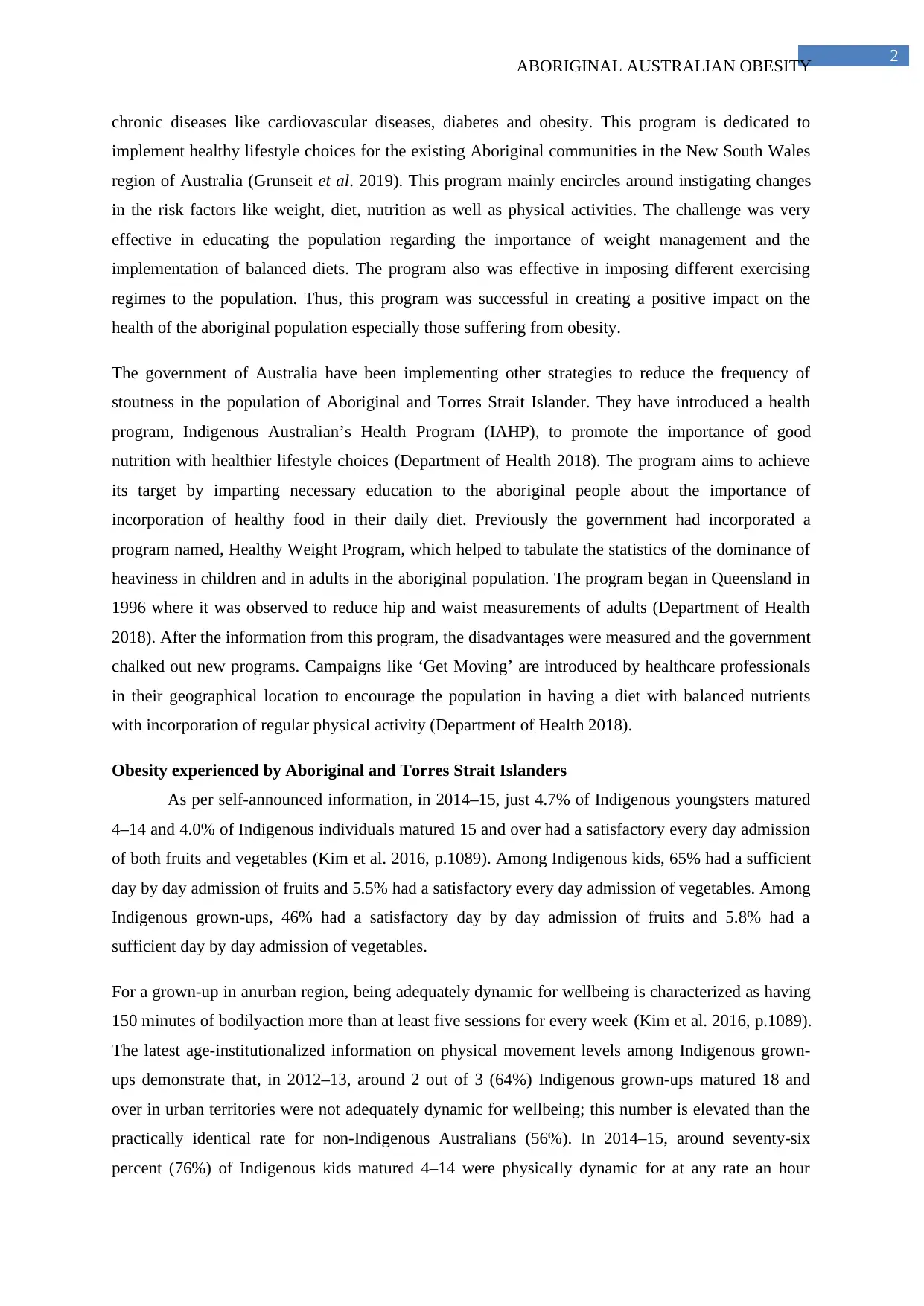
2
ABORIGINAL AUSTRALIAN OBESITY
chronic diseases like cardiovascular diseases, diabetes and obesity. This program is dedicated to
implement healthy lifestyle choices for the existing Aboriginal communities in the New South Wales
region of Australia (Grunseit et al. 2019). This program mainly encircles around instigating changes
in the risk factors like weight, diet, nutrition as well as physical activities. The challenge was very
effective in educating the population regarding the importance of weight management and the
implementation of balanced diets. The program also was effective in imposing different exercising
regimes to the population. Thus, this program was successful in creating a positive impact on the
health of the aboriginal population especially those suffering from obesity.
The government of Australia have been implementing other strategies to reduce the frequency of
stoutness in the population of Aboriginal and Torres Strait Islander. They have introduced a health
program, Indigenous Australian’s Health Program (IAHP), to promote the importance of good
nutrition with healthier lifestyle choices (Department of Health 2018). The program aims to achieve
its target by imparting necessary education to the aboriginal people about the importance of
incorporation of healthy food in their daily diet. Previously the government had incorporated a
program named, Healthy Weight Program, which helped to tabulate the statistics of the dominance of
heaviness in children and in adults in the aboriginal population. The program began in Queensland in
1996 where it was observed to reduce hip and waist measurements of adults (Department of Health
2018). After the information from this program, the disadvantages were measured and the government
chalked out new programs. Campaigns like ‘Get Moving’ are introduced by healthcare professionals
in their geographical location to encourage the population in having a diet with balanced nutrients
with incorporation of regular physical activity (Department of Health 2018).
Obesity experienced by Aboriginal and Torres Strait Islanders
As per self-announced information, in 2014–15, just 4.7% of Indigenous youngsters matured
4–14 and 4.0% of Indigenous individuals matured 15 and over had a satisfactory every day admission
of both fruits and vegetables (Kim et al. 2016, p.1089). Among Indigenous kids, 65% had a sufficient
day by day admission of fruits and 5.5% had a satisfactory every day admission of vegetables. Among
Indigenous grown-ups, 46% had a satisfactory day by day admission of fruits and 5.8% had a
sufficient day by day admission of vegetables.
For a grown-up in anurban region, being adequately dynamic for wellbeing is characterized as having
150 minutes of bodilyaction more than at least five sessions for every week (Kim et al. 2016, p.1089).
The latest age-institutionalized information on physical movement levels among Indigenous grown-
ups demonstrate that, in 2012–13, around 2 out of 3 (64%) Indigenous grown-ups matured 18 and
over in urban territories were not adequately dynamic for wellbeing; this number is elevated than the
practically identical rate for non-Indigenous Australians (56%). In 2014–15, around seventy-six
percent (76%) of Indigenous kids matured 4–14 were physically dynamic for at any rate an hour
ABORIGINAL AUSTRALIAN OBESITY
chronic diseases like cardiovascular diseases, diabetes and obesity. This program is dedicated to
implement healthy lifestyle choices for the existing Aboriginal communities in the New South Wales
region of Australia (Grunseit et al. 2019). This program mainly encircles around instigating changes
in the risk factors like weight, diet, nutrition as well as physical activities. The challenge was very
effective in educating the population regarding the importance of weight management and the
implementation of balanced diets. The program also was effective in imposing different exercising
regimes to the population. Thus, this program was successful in creating a positive impact on the
health of the aboriginal population especially those suffering from obesity.
The government of Australia have been implementing other strategies to reduce the frequency of
stoutness in the population of Aboriginal and Torres Strait Islander. They have introduced a health
program, Indigenous Australian’s Health Program (IAHP), to promote the importance of good
nutrition with healthier lifestyle choices (Department of Health 2018). The program aims to achieve
its target by imparting necessary education to the aboriginal people about the importance of
incorporation of healthy food in their daily diet. Previously the government had incorporated a
program named, Healthy Weight Program, which helped to tabulate the statistics of the dominance of
heaviness in children and in adults in the aboriginal population. The program began in Queensland in
1996 where it was observed to reduce hip and waist measurements of adults (Department of Health
2018). After the information from this program, the disadvantages were measured and the government
chalked out new programs. Campaigns like ‘Get Moving’ are introduced by healthcare professionals
in their geographical location to encourage the population in having a diet with balanced nutrients
with incorporation of regular physical activity (Department of Health 2018).
Obesity experienced by Aboriginal and Torres Strait Islanders
As per self-announced information, in 2014–15, just 4.7% of Indigenous youngsters matured
4–14 and 4.0% of Indigenous individuals matured 15 and over had a satisfactory every day admission
of both fruits and vegetables (Kim et al. 2016, p.1089). Among Indigenous kids, 65% had a sufficient
day by day admission of fruits and 5.5% had a satisfactory every day admission of vegetables. Among
Indigenous grown-ups, 46% had a satisfactory day by day admission of fruits and 5.8% had a
sufficient day by day admission of vegetables.
For a grown-up in anurban region, being adequately dynamic for wellbeing is characterized as having
150 minutes of bodilyaction more than at least five sessions for every week (Kim et al. 2016, p.1089).
The latest age-institutionalized information on physical movement levels among Indigenous grown-
ups demonstrate that, in 2012–13, around 2 out of 3 (64%) Indigenous grown-ups matured 18 and
over in urban territories were not adequately dynamic for wellbeing; this number is elevated than the
practically identical rate for non-Indigenous Australians (56%). In 2014–15, around seventy-six
percent (76%) of Indigenous kids matured 4–14 were physically dynamic for at any rate an hour
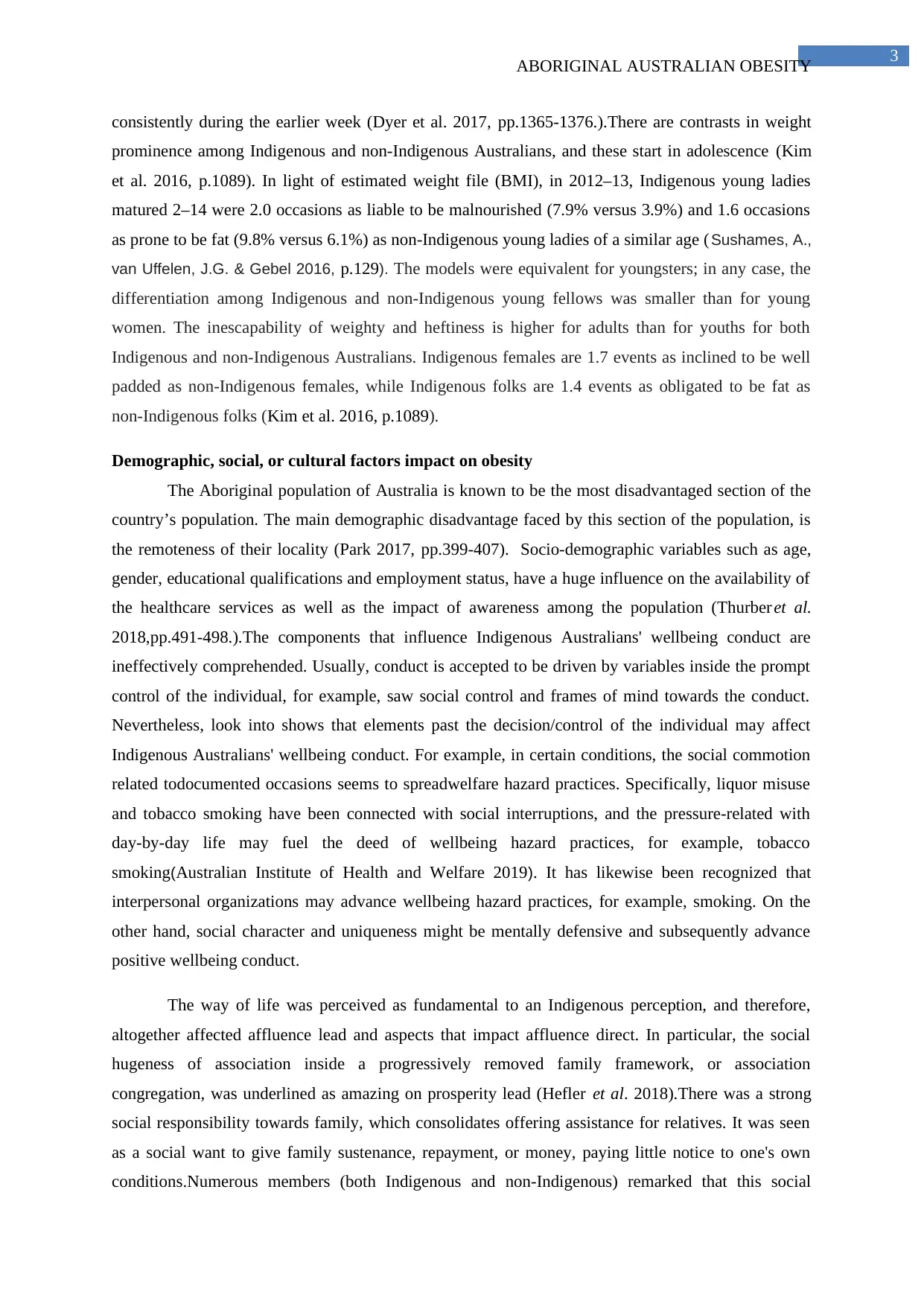
3
ABORIGINAL AUSTRALIAN OBESITY
consistently during the earlier week (Dyer et al. 2017, pp.1365-1376.).There are contrasts in weight
prominence among Indigenous and non-Indigenous Australians, and these start in adolescence (Kim
et al. 2016, p.1089). In light of estimated weight file (BMI), in 2012–13, Indigenous young ladies
matured 2–14 were 2.0 occasions as liable to be malnourished (7.9% versus 3.9%) and 1.6 occasions
as prone to be fat (9.8% versus 6.1%) as non-Indigenous young ladies of a similar age (Sushames, A.,
van Uffelen, J.G. & Gebel 2016, p.129). The models were equivalent for youngsters; in any case, the
differentiation among Indigenous and non-Indigenous young fellows was smaller than for young
women. The inescapability of weighty and heftiness is higher for adults than for youths for both
Indigenous and non-Indigenous Australians. Indigenous females are 1.7 events as inclined to be well
padded as non-Indigenous females, while Indigenous folks are 1.4 events as obligated to be fat as
non-Indigenous folks (Kim et al. 2016, p.1089).
Demographic, social, or cultural factors impact on obesity
The Aboriginal population of Australia is known to be the most disadvantaged section of the
country’s population. The main demographic disadvantage faced by this section of the population, is
the remoteness of their locality (Park 2017, pp.399-407). Socio-demographic variables such as age,
gender, educational qualifications and employment status, have a huge influence on the availability of
the healthcare services as well as the impact of awareness among the population (Thurber et al.
2018,pp.491-498.).The components that influence Indigenous Australians' wellbeing conduct are
ineffectively comprehended. Usually, conduct is accepted to be driven by variables inside the prompt
control of the individual, for example, saw social control and frames of mind towards the conduct.
Nevertheless, look into shows that elements past the decision/control of the individual may affect
Indigenous Australians' wellbeing conduct. For example, in certain conditions, the social commotion
related todocumented occasions seems to spreadwelfare hazard practices. Specifically, liquor misuse
and tobacco smoking have been connected with social interruptions, and the pressure-related with
day-by-day life may fuel the deed of wellbeing hazard practices, for example, tobacco
smoking(Australian Institute of Health and Welfare 2019). It has likewise been recognized that
interpersonal organizations may advance wellbeing hazard practices, for example, smoking. On the
other hand, social character and uniqueness might be mentally defensive and subsequently advance
positive wellbeing conduct.
The way of life was perceived as fundamental to an Indigenous perception, and therefore,
altogether affected affluence lead and aspects that impact affluence direct. In particular, the social
hugeness of association inside a progressively removed family framework, or association
congregation, was underlined as amazing on prosperity lead (Hefler et al. 2018).There was a strong
social responsibility towards family, which consolidates offering assistance for relatives. It was seen
as a social want to give family sustenance, repayment, or money, paying little notice to one's own
conditions.Numerous members (both Indigenous and non-Indigenous) remarked that this social
ABORIGINAL AUSTRALIAN OBESITY
consistently during the earlier week (Dyer et al. 2017, pp.1365-1376.).There are contrasts in weight
prominence among Indigenous and non-Indigenous Australians, and these start in adolescence (Kim
et al. 2016, p.1089). In light of estimated weight file (BMI), in 2012–13, Indigenous young ladies
matured 2–14 were 2.0 occasions as liable to be malnourished (7.9% versus 3.9%) and 1.6 occasions
as prone to be fat (9.8% versus 6.1%) as non-Indigenous young ladies of a similar age (Sushames, A.,
van Uffelen, J.G. & Gebel 2016, p.129). The models were equivalent for youngsters; in any case, the
differentiation among Indigenous and non-Indigenous young fellows was smaller than for young
women. The inescapability of weighty and heftiness is higher for adults than for youths for both
Indigenous and non-Indigenous Australians. Indigenous females are 1.7 events as inclined to be well
padded as non-Indigenous females, while Indigenous folks are 1.4 events as obligated to be fat as
non-Indigenous folks (Kim et al. 2016, p.1089).
Demographic, social, or cultural factors impact on obesity
The Aboriginal population of Australia is known to be the most disadvantaged section of the
country’s population. The main demographic disadvantage faced by this section of the population, is
the remoteness of their locality (Park 2017, pp.399-407). Socio-demographic variables such as age,
gender, educational qualifications and employment status, have a huge influence on the availability of
the healthcare services as well as the impact of awareness among the population (Thurber et al.
2018,pp.491-498.).The components that influence Indigenous Australians' wellbeing conduct are
ineffectively comprehended. Usually, conduct is accepted to be driven by variables inside the prompt
control of the individual, for example, saw social control and frames of mind towards the conduct.
Nevertheless, look into shows that elements past the decision/control of the individual may affect
Indigenous Australians' wellbeing conduct. For example, in certain conditions, the social commotion
related todocumented occasions seems to spreadwelfare hazard practices. Specifically, liquor misuse
and tobacco smoking have been connected with social interruptions, and the pressure-related with
day-by-day life may fuel the deed of wellbeing hazard practices, for example, tobacco
smoking(Australian Institute of Health and Welfare 2019). It has likewise been recognized that
interpersonal organizations may advance wellbeing hazard practices, for example, smoking. On the
other hand, social character and uniqueness might be mentally defensive and subsequently advance
positive wellbeing conduct.
The way of life was perceived as fundamental to an Indigenous perception, and therefore,
altogether affected affluence lead and aspects that impact affluence direct. In particular, the social
hugeness of association inside a progressively removed family framework, or association
congregation, was underlined as amazing on prosperity lead (Hefler et al. 2018).There was a strong
social responsibility towards family, which consolidates offering assistance for relatives. It was seen
as a social want to give family sustenance, repayment, or money, paying little notice to one's own
conditions.Numerous members (both Indigenous and non-Indigenous) remarked that this social
Secure Best Marks with AI Grader
Need help grading? Try our AI Grader for instant feedback on your assignments.
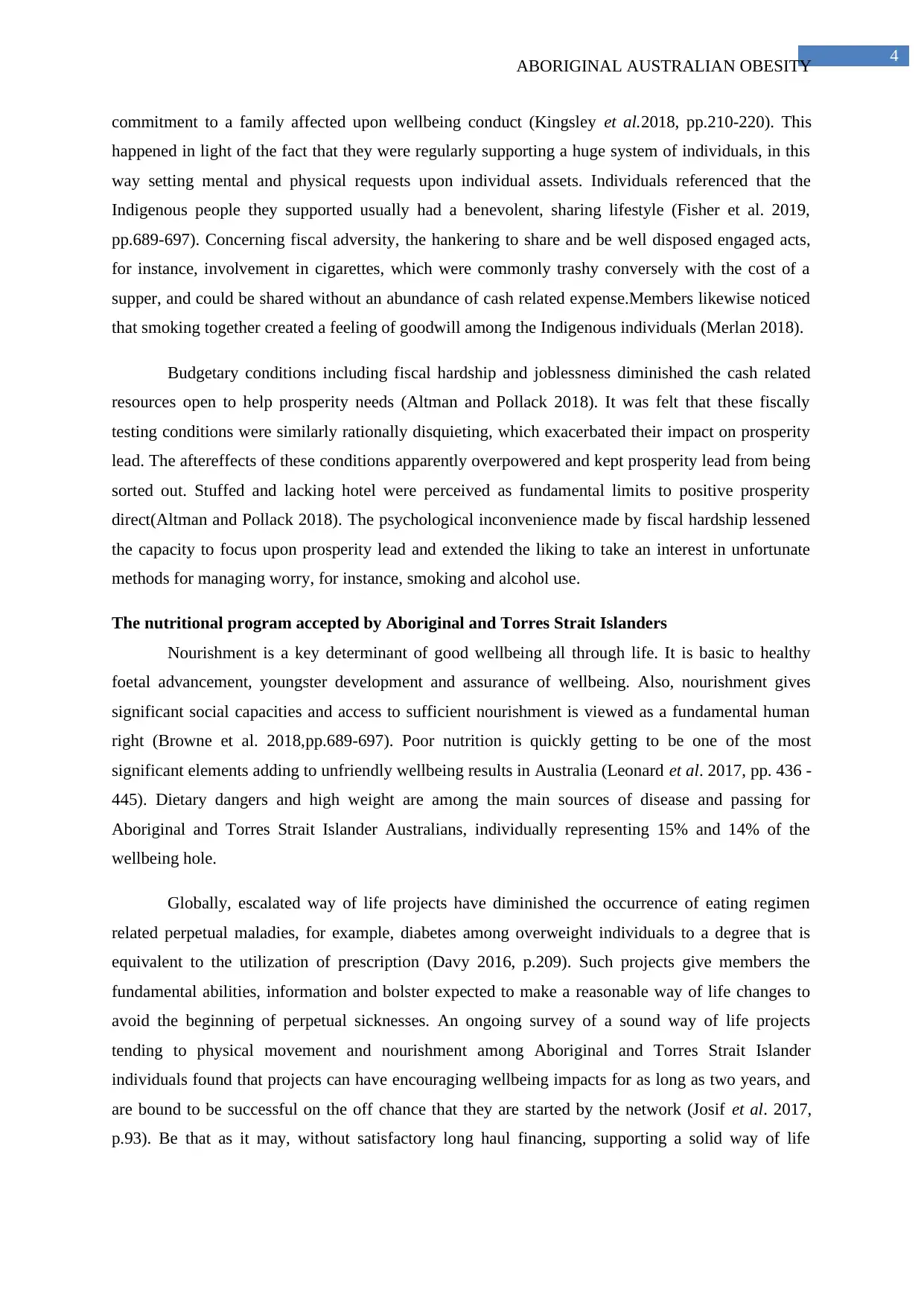
4
ABORIGINAL AUSTRALIAN OBESITY
commitment to a family affected upon wellbeing conduct (Kingsley et al.2018, pp.210-220). This
happened in light of the fact that they were regularly supporting a huge system of individuals, in this
way setting mental and physical requests upon individual assets. Individuals referenced that the
Indigenous people they supported usually had a benevolent, sharing lifestyle (Fisher et al. 2019,
pp.689-697). Concerning fiscal adversity, the hankering to share and be well disposed engaged acts,
for instance, involvement in cigarettes, which were commonly trashy conversely with the cost of a
supper, and could be shared without an abundance of cash related expense.Members likewise noticed
that smoking together created a feeling of goodwill among the Indigenous individuals (Merlan 2018).
Budgetary conditions including fiscal hardship and joblessness diminished the cash related
resources open to help prosperity needs (Altman and Pollack 2018). It was felt that these fiscally
testing conditions were similarly rationally disquieting, which exacerbated their impact on prosperity
lead. The aftereffects of these conditions apparently overpowered and kept prosperity lead from being
sorted out. Stuffed and lacking hotel were perceived as fundamental limits to positive prosperity
direct(Altman and Pollack 2018). The psychological inconvenience made by fiscal hardship lessened
the capacity to focus upon prosperity lead and extended the liking to take an interest in unfortunate
methods for managing worry, for instance, smoking and alcohol use.
The nutritional program accepted by Aboriginal and Torres Strait Islanders
Nourishment is a key determinant of good wellbeing all through life. It is basic to healthy
foetal advancement, youngster development and assurance of wellbeing. Also, nourishment gives
significant social capacities and access to sufficient nourishment is viewed as a fundamental human
right (Browne et al. 2018,pp.689-697). Poor nutrition is quickly getting to be one of the most
significant elements adding to unfriendly wellbeing results in Australia (Leonard et al. 2017, pp. 436 -
445). Dietary dangers and high weight are among the main sources of disease and passing for
Aboriginal and Torres Strait Islander Australians, individually representing 15% and 14% of the
wellbeing hole.
Globally, escalated way of life projects have diminished the occurrence of eating regimen
related perpetual maladies, for example, diabetes among overweight individuals to a degree that is
equivalent to the utilization of prescription (Davy 2016, p.209). Such projects give members the
fundamental abilities, information and bolster expected to make a reasonable way of life changes to
avoid the beginning of perpetual sicknesses. An ongoing survey of a sound way of life projects
tending to physical movement and nourishment among Aboriginal and Torres Strait Islander
individuals found that projects can have encouraging wellbeing impacts for as long as two years, and
are bound to be successful on the off chance that they are started by the network (Josif et al. 2017,
p.93). Be that as it may, without satisfactory long haul financing, supporting a solid way of life
ABORIGINAL AUSTRALIAN OBESITY
commitment to a family affected upon wellbeing conduct (Kingsley et al.2018, pp.210-220). This
happened in light of the fact that they were regularly supporting a huge system of individuals, in this
way setting mental and physical requests upon individual assets. Individuals referenced that the
Indigenous people they supported usually had a benevolent, sharing lifestyle (Fisher et al. 2019,
pp.689-697). Concerning fiscal adversity, the hankering to share and be well disposed engaged acts,
for instance, involvement in cigarettes, which were commonly trashy conversely with the cost of a
supper, and could be shared without an abundance of cash related expense.Members likewise noticed
that smoking together created a feeling of goodwill among the Indigenous individuals (Merlan 2018).
Budgetary conditions including fiscal hardship and joblessness diminished the cash related
resources open to help prosperity needs (Altman and Pollack 2018). It was felt that these fiscally
testing conditions were similarly rationally disquieting, which exacerbated their impact on prosperity
lead. The aftereffects of these conditions apparently overpowered and kept prosperity lead from being
sorted out. Stuffed and lacking hotel were perceived as fundamental limits to positive prosperity
direct(Altman and Pollack 2018). The psychological inconvenience made by fiscal hardship lessened
the capacity to focus upon prosperity lead and extended the liking to take an interest in unfortunate
methods for managing worry, for instance, smoking and alcohol use.
The nutritional program accepted by Aboriginal and Torres Strait Islanders
Nourishment is a key determinant of good wellbeing all through life. It is basic to healthy
foetal advancement, youngster development and assurance of wellbeing. Also, nourishment gives
significant social capacities and access to sufficient nourishment is viewed as a fundamental human
right (Browne et al. 2018,pp.689-697). Poor nutrition is quickly getting to be one of the most
significant elements adding to unfriendly wellbeing results in Australia (Leonard et al. 2017, pp. 436 -
445). Dietary dangers and high weight are among the main sources of disease and passing for
Aboriginal and Torres Strait Islander Australians, individually representing 15% and 14% of the
wellbeing hole.
Globally, escalated way of life projects have diminished the occurrence of eating regimen
related perpetual maladies, for example, diabetes among overweight individuals to a degree that is
equivalent to the utilization of prescription (Davy 2016, p.209). Such projects give members the
fundamental abilities, information and bolster expected to make a reasonable way of life changes to
avoid the beginning of perpetual sicknesses. An ongoing survey of a sound way of life projects
tending to physical movement and nourishment among Aboriginal and Torres Strait Islander
individuals found that projects can have encouraging wellbeing impacts for as long as two years, and
are bound to be successful on the off chance that they are started by the network (Josif et al. 2017,
p.93). Be that as it may, without satisfactory long haul financing, supporting a solid way of life
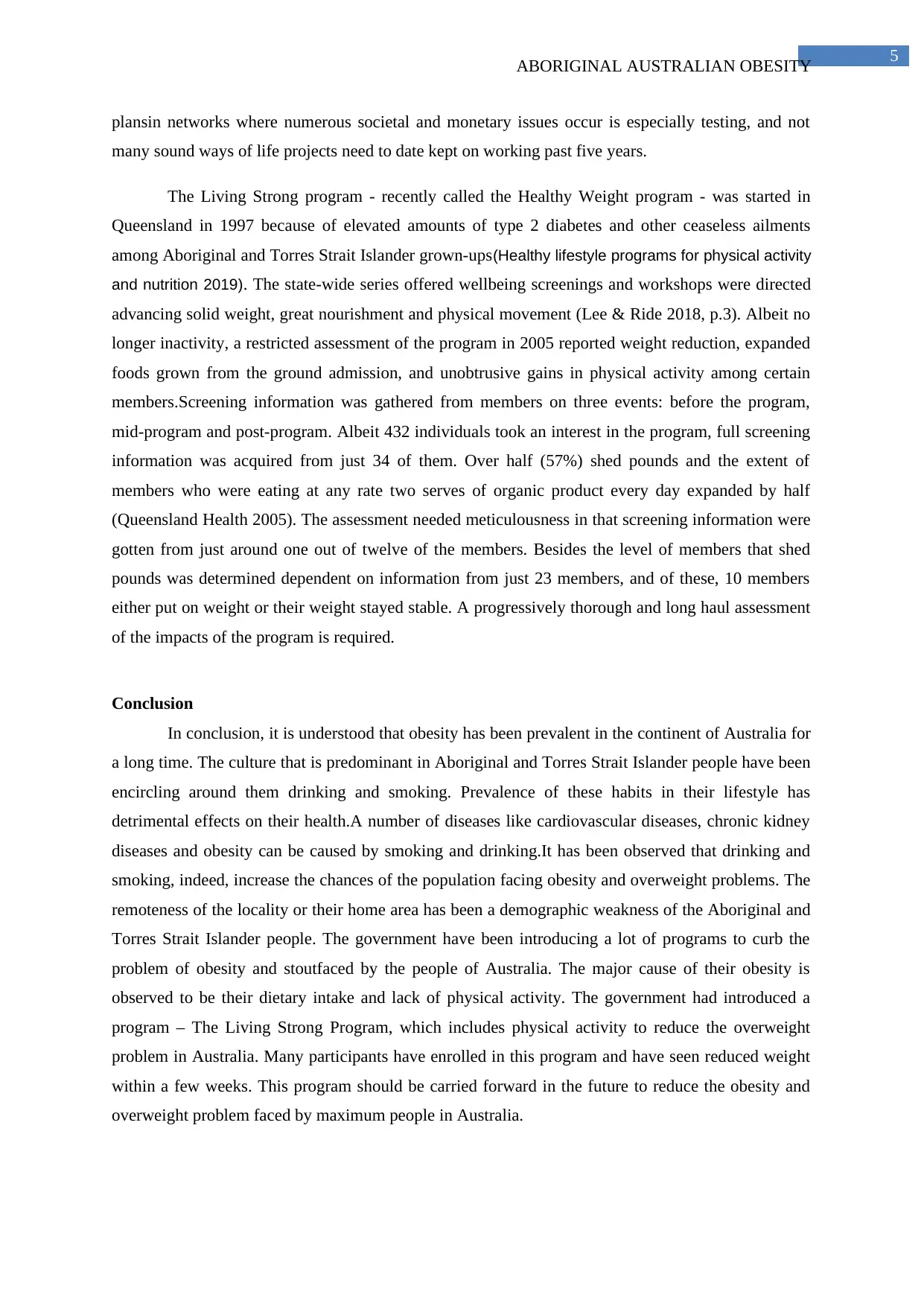
5
ABORIGINAL AUSTRALIAN OBESITY
plansin networks where numerous societal and monetary issues occur is especially testing, and not
many sound ways of life projects need to date kept on working past five years.
The Living Strong program - recently called the Healthy Weight program - was started in
Queensland in 1997 because of elevated amounts of type 2 diabetes and other ceaseless ailments
among Aboriginal and Torres Strait Islander grown-ups(Healthy lifestyle programs for physical activity
and nutrition 2019). The state-wide series offered wellbeing screenings and workshops were directed
advancing solid weight, great nourishment and physical movement (Lee & Ride 2018, p.3). Albeit no
longer inactivity, a restricted assessment of the program in 2005 reported weight reduction, expanded
foods grown from the ground admission, and unobtrusive gains in physical activity among certain
members.Screening information was gathered from members on three events: before the program,
mid-program and post-program. Albeit 432 individuals took an interest in the program, full screening
information was acquired from just 34 of them. Over half (57%) shed pounds and the extent of
members who were eating at any rate two serves of organic product every day expanded by half
(Queensland Health 2005). The assessment needed meticulousness in that screening information were
gotten from just around one out of twelve of the members. Besides the level of members that shed
pounds was determined dependent on information from just 23 members, and of these, 10 members
either put on weight or their weight stayed stable. A progressively thorough and long haul assessment
of the impacts of the program is required.
Conclusion
In conclusion, it is understood that obesity has been prevalent in the continent of Australia for
a long time. The culture that is predominant in Aboriginal and Torres Strait Islander people have been
encircling around them drinking and smoking. Prevalence of these habits in their lifestyle has
detrimental effects on their health.A number of diseases like cardiovascular diseases, chronic kidney
diseases and obesity can be caused by smoking and drinking.It has been observed that drinking and
smoking, indeed, increase the chances of the population facing obesity and overweight problems. The
remoteness of the locality or their home area has been a demographic weakness of the Aboriginal and
Torres Strait Islander people. The government have been introducing a lot of programs to curb the
problem of obesity and stoutfaced by the people of Australia. The major cause of their obesity is
observed to be their dietary intake and lack of physical activity. The government had introduced a
program – The Living Strong Program, which includes physical activity to reduce the overweight
problem in Australia. Many participants have enrolled in this program and have seen reduced weight
within a few weeks. This program should be carried forward in the future to reduce the obesity and
overweight problem faced by maximum people in Australia.
ABORIGINAL AUSTRALIAN OBESITY
plansin networks where numerous societal and monetary issues occur is especially testing, and not
many sound ways of life projects need to date kept on working past five years.
The Living Strong program - recently called the Healthy Weight program - was started in
Queensland in 1997 because of elevated amounts of type 2 diabetes and other ceaseless ailments
among Aboriginal and Torres Strait Islander grown-ups(Healthy lifestyle programs for physical activity
and nutrition 2019). The state-wide series offered wellbeing screenings and workshops were directed
advancing solid weight, great nourishment and physical movement (Lee & Ride 2018, p.3). Albeit no
longer inactivity, a restricted assessment of the program in 2005 reported weight reduction, expanded
foods grown from the ground admission, and unobtrusive gains in physical activity among certain
members.Screening information was gathered from members on three events: before the program,
mid-program and post-program. Albeit 432 individuals took an interest in the program, full screening
information was acquired from just 34 of them. Over half (57%) shed pounds and the extent of
members who were eating at any rate two serves of organic product every day expanded by half
(Queensland Health 2005). The assessment needed meticulousness in that screening information were
gotten from just around one out of twelve of the members. Besides the level of members that shed
pounds was determined dependent on information from just 23 members, and of these, 10 members
either put on weight or their weight stayed stable. A progressively thorough and long haul assessment
of the impacts of the program is required.
Conclusion
In conclusion, it is understood that obesity has been prevalent in the continent of Australia for
a long time. The culture that is predominant in Aboriginal and Torres Strait Islander people have been
encircling around them drinking and smoking. Prevalence of these habits in their lifestyle has
detrimental effects on their health.A number of diseases like cardiovascular diseases, chronic kidney
diseases and obesity can be caused by smoking and drinking.It has been observed that drinking and
smoking, indeed, increase the chances of the population facing obesity and overweight problems. The
remoteness of the locality or their home area has been a demographic weakness of the Aboriginal and
Torres Strait Islander people. The government have been introducing a lot of programs to curb the
problem of obesity and stoutfaced by the people of Australia. The major cause of their obesity is
observed to be their dietary intake and lack of physical activity. The government had introduced a
program – The Living Strong Program, which includes physical activity to reduce the overweight
problem in Australia. Many participants have enrolled in this program and have seen reduced weight
within a few weeks. This program should be carried forward in the future to reduce the obesity and
overweight problem faced by maximum people in Australia.
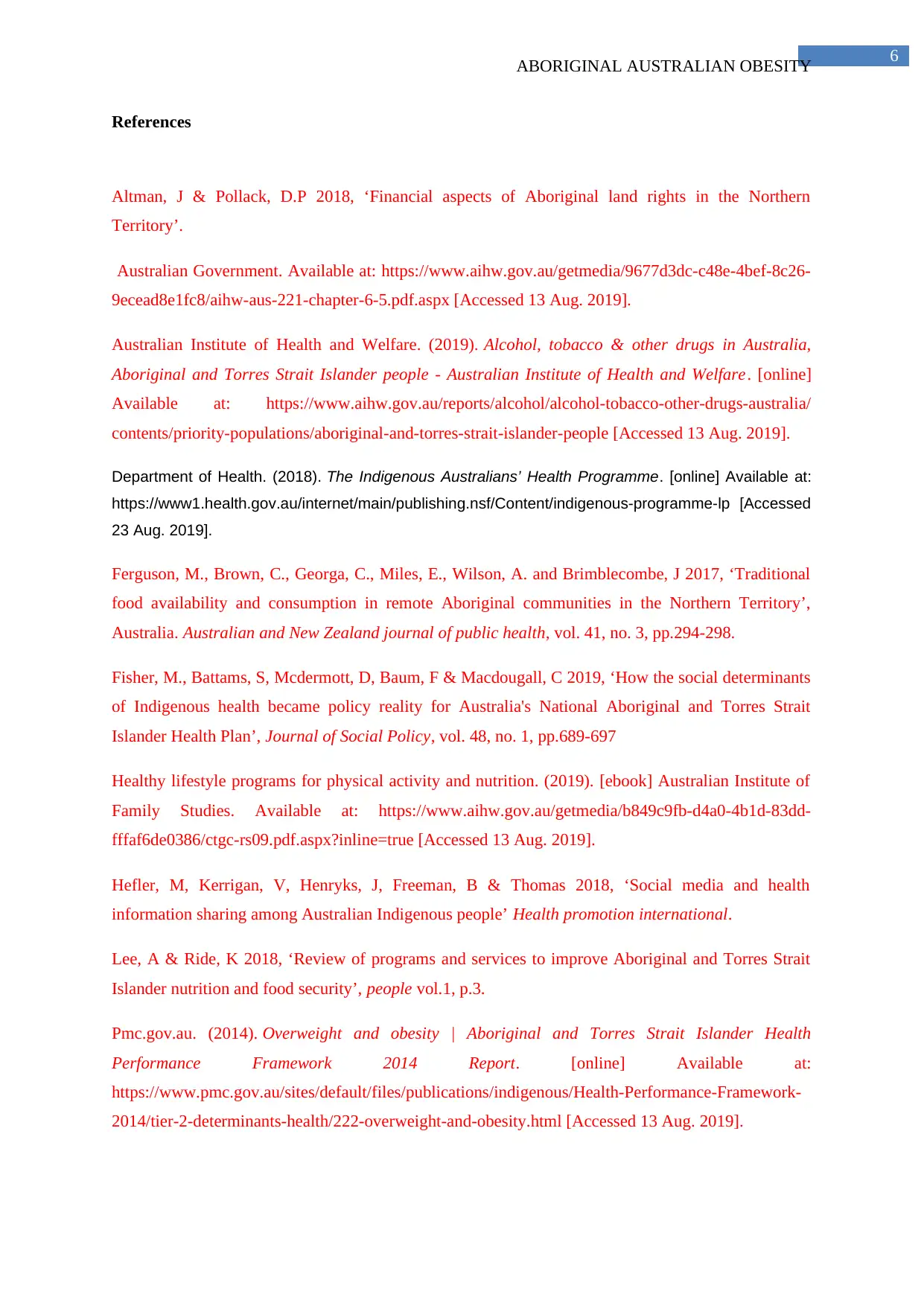
6
ABORIGINAL AUSTRALIAN OBESITY
References
Altman, J & Pollack, D.P 2018, ‘Financial aspects of Aboriginal land rights in the Northern
Territory’.
Australian Government. Available at: https://www.aihw.gov.au/getmedia/9677d3dc-c48e-4bef-8c26-
9ecead8e1fc8/aihw-aus-221-chapter-6-5.pdf.aspx [Accessed 13 Aug. 2019].
Australian Institute of Health and Welfare. (2019). Alcohol, tobacco & other drugs in Australia,
Aboriginal and Torres Strait Islander people - Australian Institute of Health and Welfare. [online]
Available at: https://www.aihw.gov.au/reports/alcohol/alcohol-tobacco-other-drugs-australia/
contents/priority-populations/aboriginal-and-torres-strait-islander-people [Accessed 13 Aug. 2019].
Department of Health. (2018). The Indigenous Australians’ Health Programme. [online] Available at:
https://www1.health.gov.au/internet/main/publishing.nsf/Content/indigenous-programme-lp [Accessed
23 Aug. 2019].
Ferguson, M., Brown, C., Georga, C., Miles, E., Wilson, A. and Brimblecombe, J 2017, ‘Traditional
food availability and consumption in remote Aboriginal communities in the Northern Territory’,
Australia. Australian and New Zealand journal of public health, vol. 41, no. 3, pp.294-298.
Fisher, M., Battams, S, Mcdermott, D, Baum, F & Macdougall, C 2019, ‘How the social determinants
of Indigenous health became policy reality for Australia's National Aboriginal and Torres Strait
Islander Health Plan’, Journal of Social Policy, vol. 48, no. 1, pp.689-697
Healthy lifestyle programs for physical activity and nutrition. (2019). [ebook] Australian Institute of
Family Studies. Available at: https://www.aihw.gov.au/getmedia/b849c9fb-d4a0-4b1d-83dd-
fffaf6de0386/ctgc-rs09.pdf.aspx?inline=true [Accessed 13 Aug. 2019].
Hefler, M, Kerrigan, V, Henryks, J, Freeman, B & Thomas 2018, ‘Social media and health
information sharing among Australian Indigenous people’ Health promotion international.
Lee, A & Ride, K 2018, ‘Review of programs and services to improve Aboriginal and Torres Strait
Islander nutrition and food security’, people vol.1, p.3.
Pmc.gov.au. (2014). Overweight and obesity | Aboriginal and Torres Strait Islander Health
Performance Framework 2014 Report. [online] Available at:
https://www.pmc.gov.au/sites/default/files/publications/indigenous/Health-Performance-Framework-
2014/tier-2-determinants-health/222-overweight-and-obesity.html [Accessed 13 Aug. 2019].
ABORIGINAL AUSTRALIAN OBESITY
References
Altman, J & Pollack, D.P 2018, ‘Financial aspects of Aboriginal land rights in the Northern
Territory’.
Australian Government. Available at: https://www.aihw.gov.au/getmedia/9677d3dc-c48e-4bef-8c26-
9ecead8e1fc8/aihw-aus-221-chapter-6-5.pdf.aspx [Accessed 13 Aug. 2019].
Australian Institute of Health and Welfare. (2019). Alcohol, tobacco & other drugs in Australia,
Aboriginal and Torres Strait Islander people - Australian Institute of Health and Welfare. [online]
Available at: https://www.aihw.gov.au/reports/alcohol/alcohol-tobacco-other-drugs-australia/
contents/priority-populations/aboriginal-and-torres-strait-islander-people [Accessed 13 Aug. 2019].
Department of Health. (2018). The Indigenous Australians’ Health Programme. [online] Available at:
https://www1.health.gov.au/internet/main/publishing.nsf/Content/indigenous-programme-lp [Accessed
23 Aug. 2019].
Ferguson, M., Brown, C., Georga, C., Miles, E., Wilson, A. and Brimblecombe, J 2017, ‘Traditional
food availability and consumption in remote Aboriginal communities in the Northern Territory’,
Australia. Australian and New Zealand journal of public health, vol. 41, no. 3, pp.294-298.
Fisher, M., Battams, S, Mcdermott, D, Baum, F & Macdougall, C 2019, ‘How the social determinants
of Indigenous health became policy reality for Australia's National Aboriginal and Torres Strait
Islander Health Plan’, Journal of Social Policy, vol. 48, no. 1, pp.689-697
Healthy lifestyle programs for physical activity and nutrition. (2019). [ebook] Australian Institute of
Family Studies. Available at: https://www.aihw.gov.au/getmedia/b849c9fb-d4a0-4b1d-83dd-
fffaf6de0386/ctgc-rs09.pdf.aspx?inline=true [Accessed 13 Aug. 2019].
Hefler, M, Kerrigan, V, Henryks, J, Freeman, B & Thomas 2018, ‘Social media and health
information sharing among Australian Indigenous people’ Health promotion international.
Lee, A & Ride, K 2018, ‘Review of programs and services to improve Aboriginal and Torres Strait
Islander nutrition and food security’, people vol.1, p.3.
Pmc.gov.au. (2014). Overweight and obesity | Aboriginal and Torres Strait Islander Health
Performance Framework 2014 Report. [online] Available at:
https://www.pmc.gov.au/sites/default/files/publications/indigenous/Health-Performance-Framework-
2014/tier-2-determinants-health/222-overweight-and-obesity.html [Accessed 13 Aug. 2019].
Paraphrase This Document
Need a fresh take? Get an instant paraphrase of this document with our AI Paraphraser
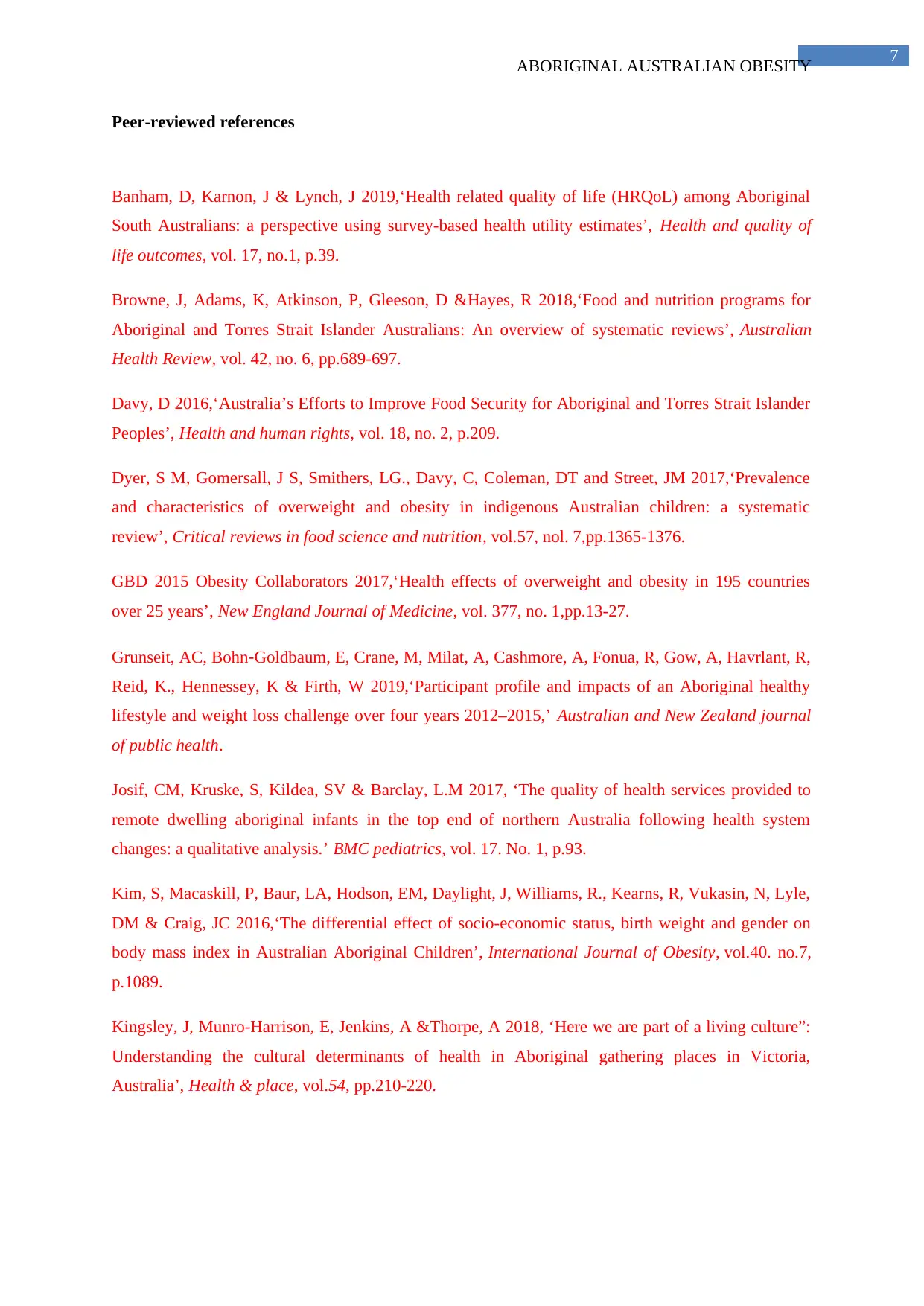
7
ABORIGINAL AUSTRALIAN OBESITY
Peer-reviewed references
Banham, D, Karnon, J & Lynch, J 2019,‘Health related quality of life (HRQoL) among Aboriginal
South Australians: a perspective using survey-based health utility estimates’, Health and quality of
life outcomes, vol. 17, no.1, p.39.
Browne, J, Adams, K, Atkinson, P, Gleeson, D &Hayes, R 2018,‘Food and nutrition programs for
Aboriginal and Torres Strait Islander Australians: An overview of systematic reviews’, Australian
Health Review, vol. 42, no. 6, pp.689-697.
Davy, D 2016,‘Australia’s Efforts to Improve Food Security for Aboriginal and Torres Strait Islander
Peoples’, Health and human rights, vol. 18, no. 2, p.209.
Dyer, S M, Gomersall, J S, Smithers, LG., Davy, C, Coleman, DT and Street, JM 2017,‘Prevalence
and characteristics of overweight and obesity in indigenous Australian children: a systematic
review’, Critical reviews in food science and nutrition, vol.57, nol. 7,pp.1365-1376.
GBD 2015 Obesity Collaborators 2017,‘Health effects of overweight and obesity in 195 countries
over 25 years’, New England Journal of Medicine, vol. 377, no. 1,pp.13-27.
Grunseit, AC, Bohn‐Goldbaum, E, Crane, M, Milat, A, Cashmore, A, Fonua, R, Gow, A, Havrlant, R,
Reid, K., Hennessey, K & Firth, W 2019,‘Participant profile and impacts of an Aboriginal healthy
lifestyle and weight loss challenge over four years 2012–2015,’ Australian and New Zealand journal
of public health.
Josif, CM, Kruske, S, Kildea, SV & Barclay, L.M 2017, ‘The quality of health services provided to
remote dwelling aboriginal infants in the top end of northern Australia following health system
changes: a qualitative analysis.’ BMC pediatrics, vol. 17. No. 1, p.93.
Kim, S, Macaskill, P, Baur, LA, Hodson, EM, Daylight, J, Williams, R., Kearns, R, Vukasin, N, Lyle,
DM & Craig, JC 2016,‘The differential effect of socio-economic status, birth weight and gender on
body mass index in Australian Aboriginal Children’, International Journal of Obesity, vol.40. no.7,
p.1089.
Kingsley, J, Munro-Harrison, E, Jenkins, A &Thorpe, A 2018, ‘Here we are part of a living culture”:
Understanding the cultural determinants of health in Aboriginal gathering places in Victoria,
Australia’, Health & place, vol.54, pp.210-220.
ABORIGINAL AUSTRALIAN OBESITY
Peer-reviewed references
Banham, D, Karnon, J & Lynch, J 2019,‘Health related quality of life (HRQoL) among Aboriginal
South Australians: a perspective using survey-based health utility estimates’, Health and quality of
life outcomes, vol. 17, no.1, p.39.
Browne, J, Adams, K, Atkinson, P, Gleeson, D &Hayes, R 2018,‘Food and nutrition programs for
Aboriginal and Torres Strait Islander Australians: An overview of systematic reviews’, Australian
Health Review, vol. 42, no. 6, pp.689-697.
Davy, D 2016,‘Australia’s Efforts to Improve Food Security for Aboriginal and Torres Strait Islander
Peoples’, Health and human rights, vol. 18, no. 2, p.209.
Dyer, S M, Gomersall, J S, Smithers, LG., Davy, C, Coleman, DT and Street, JM 2017,‘Prevalence
and characteristics of overweight and obesity in indigenous Australian children: a systematic
review’, Critical reviews in food science and nutrition, vol.57, nol. 7,pp.1365-1376.
GBD 2015 Obesity Collaborators 2017,‘Health effects of overweight and obesity in 195 countries
over 25 years’, New England Journal of Medicine, vol. 377, no. 1,pp.13-27.
Grunseit, AC, Bohn‐Goldbaum, E, Crane, M, Milat, A, Cashmore, A, Fonua, R, Gow, A, Havrlant, R,
Reid, K., Hennessey, K & Firth, W 2019,‘Participant profile and impacts of an Aboriginal healthy
lifestyle and weight loss challenge over four years 2012–2015,’ Australian and New Zealand journal
of public health.
Josif, CM, Kruske, S, Kildea, SV & Barclay, L.M 2017, ‘The quality of health services provided to
remote dwelling aboriginal infants in the top end of northern Australia following health system
changes: a qualitative analysis.’ BMC pediatrics, vol. 17. No. 1, p.93.
Kim, S, Macaskill, P, Baur, LA, Hodson, EM, Daylight, J, Williams, R., Kearns, R, Vukasin, N, Lyle,
DM & Craig, JC 2016,‘The differential effect of socio-economic status, birth weight and gender on
body mass index in Australian Aboriginal Children’, International Journal of Obesity, vol.40. no.7,
p.1089.
Kingsley, J, Munro-Harrison, E, Jenkins, A &Thorpe, A 2018, ‘Here we are part of a living culture”:
Understanding the cultural determinants of health in Aboriginal gathering places in Victoria,
Australia’, Health & place, vol.54, pp.210-220.
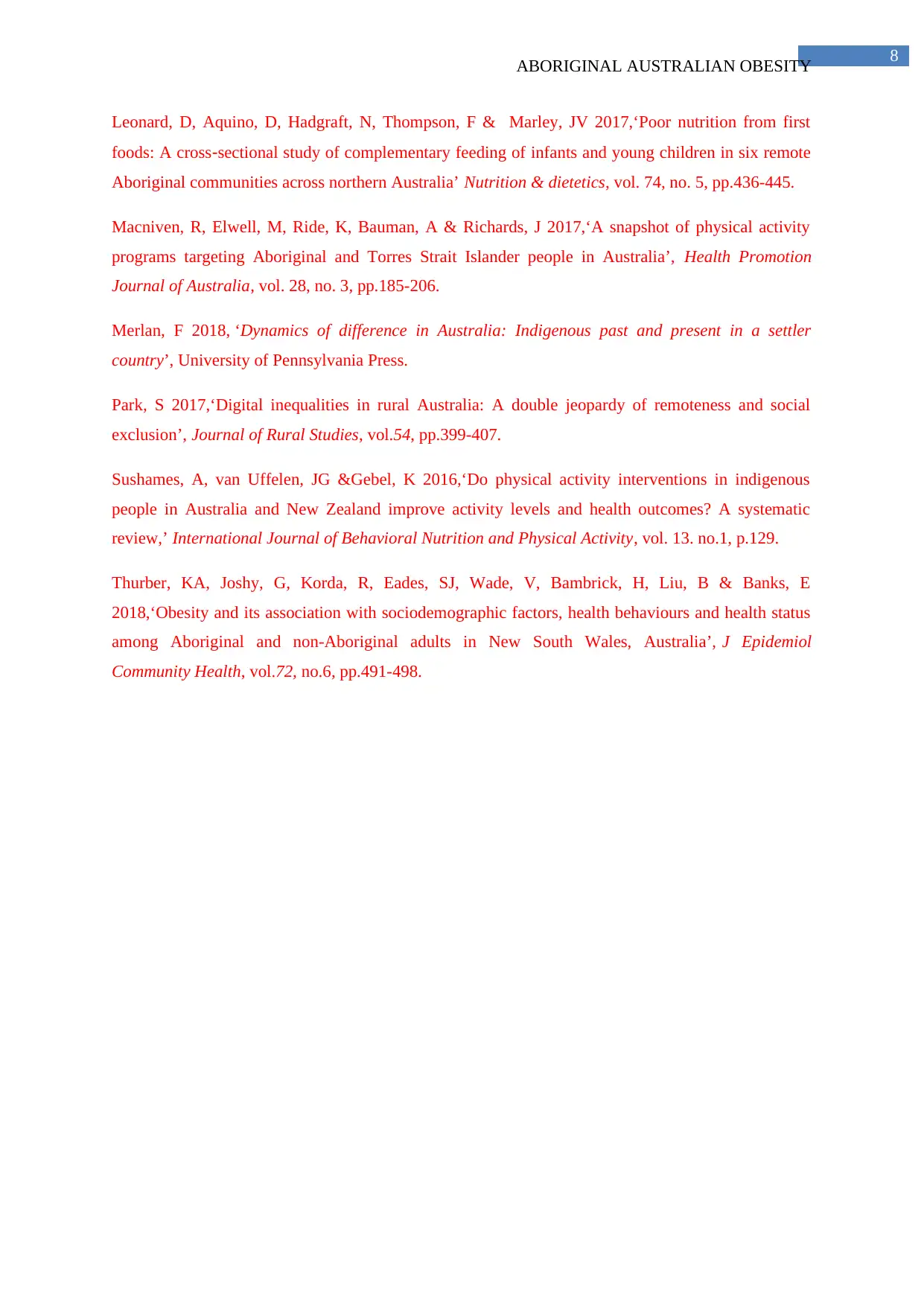
8
ABORIGINAL AUSTRALIAN OBESITY
Leonard, D, Aquino, D, Hadgraft, N, Thompson, F & Marley, JV 2017,‘Poor nutrition from first
foods: A cross‐sectional study of complementary feeding of infants and young children in six remote
Aboriginal communities across northern Australia’ Nutrition & dietetics, vol. 74, no. 5, pp.436-445.
Macniven, R, Elwell, M, Ride, K, Bauman, A & Richards, J 2017,‘A snapshot of physical activity
programs targeting Aboriginal and Torres Strait Islander people in Australia’, Health Promotion
Journal of Australia, vol. 28, no. 3, pp.185-206.
Merlan, F 2018, ‘Dynamics of difference in Australia: Indigenous past and present in a settler
country’, University of Pennsylvania Press.
Park, S 2017,‘Digital inequalities in rural Australia: A double jeopardy of remoteness and social
exclusion’, Journal of Rural Studies, vol.54, pp.399-407.
Sushames, A, van Uffelen, JG &Gebel, K 2016,‘Do physical activity interventions in indigenous
people in Australia and New Zealand improve activity levels and health outcomes? A systematic
review,’ International Journal of Behavioral Nutrition and Physical Activity, vol. 13. no.1, p.129.
Thurber, KA, Joshy, G, Korda, R, Eades, SJ, Wade, V, Bambrick, H, Liu, B & Banks, E
2018,‘Obesity and its association with sociodemographic factors, health behaviours and health status
among Aboriginal and non-Aboriginal adults in New South Wales, Australia’, J Epidemiol
Community Health, vol.72, no.6, pp.491-498.
ABORIGINAL AUSTRALIAN OBESITY
Leonard, D, Aquino, D, Hadgraft, N, Thompson, F & Marley, JV 2017,‘Poor nutrition from first
foods: A cross‐sectional study of complementary feeding of infants and young children in six remote
Aboriginal communities across northern Australia’ Nutrition & dietetics, vol. 74, no. 5, pp.436-445.
Macniven, R, Elwell, M, Ride, K, Bauman, A & Richards, J 2017,‘A snapshot of physical activity
programs targeting Aboriginal and Torres Strait Islander people in Australia’, Health Promotion
Journal of Australia, vol. 28, no. 3, pp.185-206.
Merlan, F 2018, ‘Dynamics of difference in Australia: Indigenous past and present in a settler
country’, University of Pennsylvania Press.
Park, S 2017,‘Digital inequalities in rural Australia: A double jeopardy of remoteness and social
exclusion’, Journal of Rural Studies, vol.54, pp.399-407.
Sushames, A, van Uffelen, JG &Gebel, K 2016,‘Do physical activity interventions in indigenous
people in Australia and New Zealand improve activity levels and health outcomes? A systematic
review,’ International Journal of Behavioral Nutrition and Physical Activity, vol. 13. no.1, p.129.
Thurber, KA, Joshy, G, Korda, R, Eades, SJ, Wade, V, Bambrick, H, Liu, B & Banks, E
2018,‘Obesity and its association with sociodemographic factors, health behaviours and health status
among Aboriginal and non-Aboriginal adults in New South Wales, Australia’, J Epidemiol
Community Health, vol.72, no.6, pp.491-498.
1 out of 9
Related Documents
Your All-in-One AI-Powered Toolkit for Academic Success.
+13062052269
info@desklib.com
Available 24*7 on WhatsApp / Email
![[object Object]](/_next/static/media/star-bottom.7253800d.svg)
Unlock your academic potential
© 2024 | Zucol Services PVT LTD | All rights reserved.





